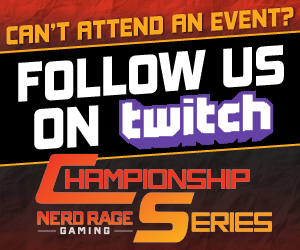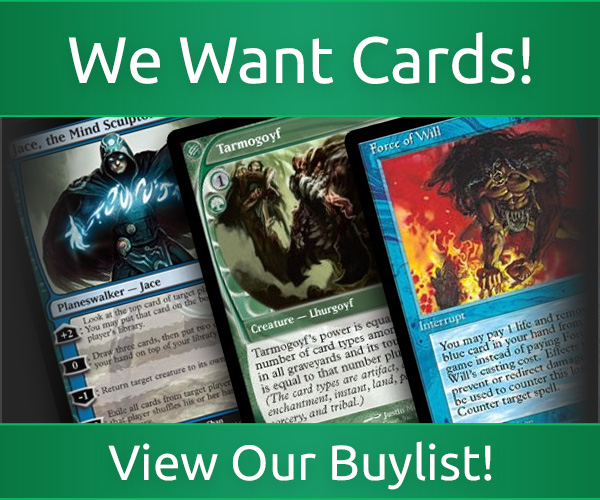The State of Modern: Quick Hit on Affinity, with Alex Javed
If there’s one universal truth about Modern, it’s this: When in doubt, get ‘em dead.
When in doubt, get ‘em dead.
There are few decks better at that than Affinity, and there are few better Affinity pilots than Alexander Javed. Alex qualified for last year’s and this year’s NRG Championship Series Championships by winning Modern CTs with Affinity, and he won this year’s spring SCG Regionals with the deck as well.
Alex took the time to provide some of his insights on Affinity, so let’s break it down.
The deck
We’ll start with Alex’s winning deck from the April CT:
Alex Javed, Affinity, 1st place, April 2017 NRG Championship Series CT+
The gameplan is simple: Flood the board with cheap artifact creatures, then use Signal Pest and Cranial Plating to push through massive amounts of damage before your opponent can do anything about it. If that fails, Inkmoth Nexus offers the Infect back-up plan.
The Untouchables
4 Arcbound Ravager
4 Etched Champion
4 Ornithopter
4 Signal Pest
4 Vault Skirge
4 Cranial Plating
4 Mox Opal
4 Springleaf Drum
4 Galvanic Blast
2 Memnite
Ornithopter and Memnite are free, which makes them ideal for a deck that runs such a tight manabase and wants to get on the board in big numbers early. Ornithopter also flies, which is big in Modern and gives it the nod as a four-of. Vault Skirge is effectively a one-drop flier with lifelink, which is well ahead of rate.
Signal Pest offers evasion to make it hard to kill in combat, which makes it an effective pseudo-pump spell. While it doesn’t pump itself, it can still enable big attacks as early as turn two, and gets out of hand in multiples.
Arcbound Ravager is almost impossible to kill productively, and offers another form of evasion in combat. If it’s blocked, it can be sacrificed to pump another creature. If it’s not blocked, another creature — or any artifact — can be sacrificed to pump it. It also offers a use for draws that are heavy on things such as Springleaf Drum, because they can be used to pump Ravager for lethal damage or close to it when they’re no longer necessary.
Etched Champion dodges basically everything, blocks basically everything, and dies to almost nothing.
“Etched Champion is usually game over if you land one and have some other threats on board or lined up,” says Alex.
Steel Overseer pumps the team to help close games out quickly. The numbers of Champions and Overseers can be tweaked to fit in Master of Etherium, which is another lord effect. The exact combination is, of course, meta-dependent; Alex generally goes without Master of Etherium, but will add some when warranted.
The numbers of Champions and Overseers can be tweaked to fit in Master of Etherium, which is another lord effect. The exact combination is, of course, meta-dependent; Alex generally goes without Master of Etherium, but will add some when warranted.
“If I had ever kept track of my win/loss percentage when I untap with a Steel Overseer it would have to be in the high 90s,” he says. “Master of Etherium is great, and he is good versus a field of other aggressive decks. But when non-damage based removal is everywhere he is pretty underwhelming. I toy with putting him in every once in a while, but for the most part he sits for me.”
Galvanic Blast provides a lot of reach for one mana to help close out games, because metalcraft is almost always on. Mox Opal and Springleaf Drum enable the ludicrous starts by offering the ability to dump your entire hand on turn 1. Cranial Plating is, well, Cranial Plating. With 42 artifacts in the deck and eight more lands that can be turned into artifacts, it pumps out a lot of damage very quickly.
The Flex Spots
As you can see, there’s not a lot of flexibility, although the numbers of some of the creatures can be tweaked depending on the exact matchups you expect.
Thoughtcast is almost always two cards for one mana, which is great. You don’t want too many copies to water down your threat density, but as a way to refuel your hand, it can’t be beat.
Welding Jar is great if you’re expecting a lot of damage-based removal or destroy effects, but can be replaced with something else in other situations.
The deck has been tuned well enough that most of it is set, but depending on the exact meta, you can run countermagic such as Spell Pierce or Stubborn Denial in the main. Usually, though, the main deck stays pretty close to the same and the sideboard is modified as necessary.
The Manabase
Eight creaturelands that can still cast almost everything in the deck are a nice bonus, especially when one of them takes advantage of the Infect mechanic to cut the game in half.
Darksteel Citadel is an indestructible artifact that makes it harder for your opponents to turn off metalcraft, because they can’t kill it. It pairs up well with Glimmervoid, because it ensures Glimmervoid always has an artifact in play.
A basic Island serves as Path to Exile protection, as well as helping to cast Thoughtcast or countermagic out of the board.
The Sideboard
Spell Pierce protects against a little bit of everything, from removal to Storm’s cantrips to Scapeshift. Because the deck is so fast, you often only have to stop one spell to be able to win the game.
from removal to Storm’s cantrips to Scapeshift. Because the deck is so fast, you often only have to stop one spell to be able to win the game.
Wear // Tear offers a flexible answer to problematic artifacts and enchantments, and can hit both at the same time. Nature’s Claim is cheaper, but as an aggro deck, you don’t want to be giving your opponent any extra life.
Whipflare is a one-sided Pyroclasm. Relic of Progenitus is graveyard hate, Blood Moon shuts down big mana decks and Ghirapur Aether Grid is a way to push through damage when you can’t attack.
Spellskite fills all its usual roles, but with Cranial Plating in the deck, it can also be a threat.
Alex has kept his sideboard pretty much the same for quite some time, with the only change being the addition of another Ghirapur Aether Grid in place of a Relic of Progenitus. Thoughtseize is somewhat common in the sideboard of Affinity decks, but according to Alex, only use it in certain metas.
“I haven’t played Thoughtseize in the sideboard for a while, mainly because Burn became a bit more popular, but now it seems to have died down a bit,” Alex says. “I kind of wanted to play Hurkyl’s Recall in the sideboard for the mirror match, but I figured another Aether Grid would be fine because it helps against other matchups also.”
Good and Bad Matchups
We’ll let Alex explain the matchups: “There are a lot of good matchups, but I think the best is game 1. Besides combo, winning game 1 is usually the most important thing to do, because after game 1 everyone has so much hate.
“There are some bad matchups (not as many as people seem to think), but I would rather them think they have a good matchup against Affinity. I don’t really think I have any bad matchups, which is why I love the deck.”
Gameplay
The gameplan is straightforward, but that doesn’t mean it’s simple. You want to dump your hand as quickly as possible to get threats on the board, but when Signal Pest triggers and Cranial Plating start coming into play, the math can get complicated in a hurry.
Your ideal opening hand is seven cards that you can have on the board before passing the turn, with at least 3-4 of them being creatures. So, something like Signal Pest-Memnite-Ornithopter-Mox Opal-Springleaf Drum-Vault Skirge-Darksteel Citadel would be a snap keep, but replacing Memnite and Vault Skirge with Galvanic Blast and Welding Jar wouldn’t always be. While you won’t always get the dream hands, playing multiple spells on turn 1 with at least a couple of them being threats is what you’re looking for.
Arcbound Ravager and Cranial Plating are the two scariest cards in the deck, and having one or both in your opener and the ability to cast or cast and equip them ahead of curve is a good start. If you can cast a Ravager on turn 1 and cast and equip a Plating on turn 2, you’re in pretty good shape.
You do need to play around sweepers and hate, but not at the expense of your ability to win. Sometimes, you have to jam a bunch of threats early even in the face of potential hate to get a bunch of early damage in so you can ride a later threat or Galvanic Blast to victory.
Ultimately, Affinity is probably the best aggro deck in Modern, and it rewards sound technical play and flexible thinking. If you ever get the chance to watch Alex or another Affinity expert play the deck, watch how many different lines of attack they take over the course of the match and how many different ways they sequence playing creatures or spells.
“With Affinity every card counts — the more you have on the board, the more you have to keep track of, the better you are doing,” Alex says. “The fun thing about Affinity is that you can play the deck different ways, waiting for the right turn to drop your Cranial Plating and hit for a big chunk or get an Infect kill in one shot. You just have to keep track of your artifact count at all times and play very tight. The deck rewards tight play.”
In the last two years, Alex Javed has won two Modern NRG Championship Series CTs and an SCG Regionals with Affinity, and he is widely regarded as an expert on the deck. Casey Laughman is editor of Nerd Rage Gaming. Email comments and questions to claughman@gmail.com.




